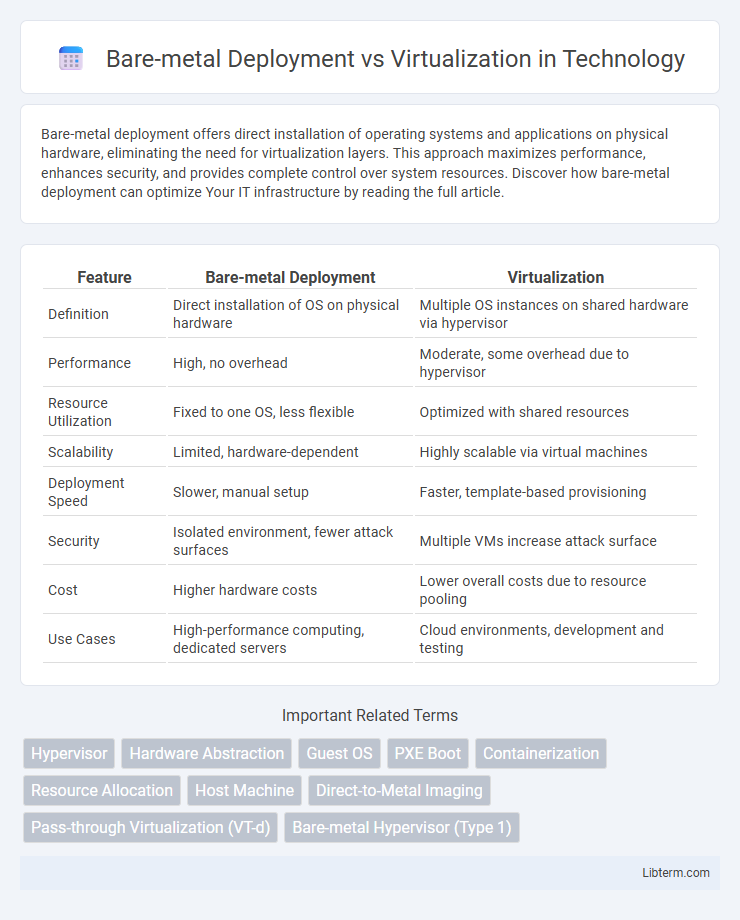Bare-metal deployment offers direct installation of operating systems and applications on physical hardware, eliminating the need for virtualization layers. This approach maximizes performance, enhances security, and provides complete control over system resources. Discover how bare-metal deployment can optimize Your IT infrastructure by reading the full article.
Table of Comparison
| Feature | Bare-metal Deployment | Virtualization |
|---|---|---|
| Definition | Direct installation of OS on physical hardware | Multiple OS instances on shared hardware via hypervisor |
| Performance | High, no overhead | Moderate, some overhead due to hypervisor |
| Resource Utilization | Fixed to one OS, less flexible | Optimized with shared resources |
| Scalability | Limited, hardware-dependent | Highly scalable via virtual machines |
| Deployment Speed | Slower, manual setup | Faster, template-based provisioning |
| Security | Isolated environment, fewer attack surfaces | Multiple VMs increase attack surface |
| Cost | Higher hardware costs | Lower overall costs due to resource pooling |
| Use Cases | High-performance computing, dedicated servers | Cloud environments, development and testing |
Introduction to Bare-metal Deployment and Virtualization
Bare-metal deployment involves installing an operating system directly on physical hardware, providing maximum performance and resource control without an intermediary layer. Virtualization creates multiple virtual machines on a single physical server by using a hypervisor, enabling efficient resource utilization and isolation between environments. Both approaches serve distinct use cases, with bare-metal excelling in high-performance scenarios and virtualization offering flexibility for multi-tenant or diverse workloads.
Understanding Bare-metal Architecture
Bare-metal deployment involves installing software directly onto physical hardware without an intervening hypervisor layer, leading to improved performance and resource utilization in demanding applications. This architecture eliminates the overhead caused by virtualization, providing direct access to hardware components such as CPUs, memory, and storage devices, which is critical for latency-sensitive environments. Understanding bare-metal architecture is essential for optimizing workloads that require maximum processing power, predictable resource allocation, and minimal abstraction between the operating system and physical infrastructure.
Fundamentals of Virtualization
Virtualization fundamentally abstracts physical hardware through a hypervisor, enabling multiple virtual machines to run on a single bare-metal server, optimizing resource utilization. Unlike bare-metal deployment, where software installs directly on the hardware, virtualization layers provide isolation, scalability, and flexibility by decoupling the operating system from physical infrastructure. Core components include the hypervisor (Type 1 or 2), virtual CPUs, memory, storage, and network interfaces, which collectively facilitate efficient workload management and dynamic resource allocation.
Key Differences Between Bare-metal and Virtualization
Bare-metal deployment involves installing an operating system directly on physical hardware, delivering maximum performance and resource utilization without any intermediary layers, while virtualization creates multiple virtual machines on a single physical server, enabling better resource flexibility and isolation. Bare-metal systems offer lower latency and higher throughput, ideal for performance-critical applications, whereas virtualization provides scalability and ease of management through hypervisors like VMware or Hyper-V. Cost efficiency varies as bare-metal requires dedicated hardware, whereas virtualization reduces hardware expenses by consolidating workloads on shared infrastructure.
Performance Comparison: Bare-metal vs Virtualization
Bare-metal deployment provides superior performance by directly utilizing hardware resources without intermediary layers, resulting in lower latency and higher throughput for demanding applications. Virtualization introduces an abstraction layer, which can lead to CPU, memory, and I/O overhead, slightly reducing raw performance compared to bare-metal. Workloads requiring maximum efficiency, such as high-frequency trading or real-time analytics, benefit more from bare-metal environments, whereas virtualization offers better flexibility and resource consolidation at the cost of some performance loss.
Security Considerations in Both Approaches
Bare-metal deployment offers enhanced security by minimizing attack surfaces, as it eliminates hypervisor vulnerabilities and provides direct hardware control, reducing risks of virtual machine escape and lateral movement. Virtualization improves security through isolation of workloads, enabling quicker recovery and efficient resource segmentation, but it introduces potential hypervisor-level threats that require rigorous patching and monitoring strategies. Both approaches demand tailored security controls: bare-metal focuses on securing physical hardware and firmware, while virtualization requires robust management of virtual networks, access controls, and hypervisor integrity.
Use Cases for Bare-metal Deployment
Bare-metal deployment excels in high-performance computing, big data analytics, and gaming servers where direct hardware access minimizes latency and maximizes resource efficiency. It is crucial for enterprises requiring stringent security and compliance, as dedicated physical servers reduce risks associated with multi-tenancy. Industries such as finance, healthcare, and telecommunications leverage bare-metal servers for mission-critical applications demanding predictable performance and consistent throughput.
Use Cases for Virtualization
Virtualization is ideal for cloud computing environments, enabling efficient resource utilization by running multiple virtual machines on a single physical server, which reduces hardware costs. It supports development and testing environments by allowing quick provisioning and rollback of isolated systems without affecting the host hardware. Virtualization also enhances disaster recovery through live migration and snapshot capabilities, providing flexible and scalable infrastructure for enterprise applications.
Cost Implications and Resource Efficiency
Bare-metal deployment offers lower latency and higher performance by directly utilizing hardware, reducing overhead costs associated with hypervisor management and licensing fees common in virtualization solutions. Virtualization enables better resource utilization through workload consolidation, allowing multiple virtual machines to share a single physical server, which can lead to reduced capital expenditure on hardware. However, virtualization often incurs additional costs for software licenses, maintenance, and potential performance degradation due to resource contention, impacting overall efficiency and total cost of ownership.
Choosing the Right Approach for Your Infrastructure
Bare-metal deployment offers superior performance and direct hardware access, making it ideal for high-demand applications requiring low latency and maximum resource utilization. Virtualization provides flexibility, scalability, and better resource management by enabling multiple virtual machines on a single physical server, reducing hardware costs. Selecting the right approach depends on workload requirements, budget constraints, and the need for scalability or dedicated resources in your infrastructure.
Bare-metal Deployment Infographic

 libterm.com
libterm.com